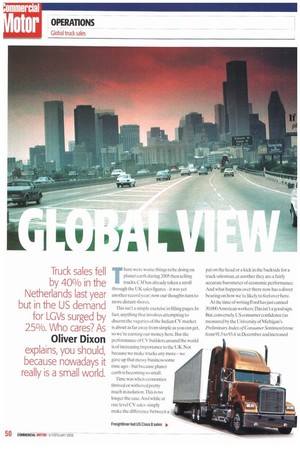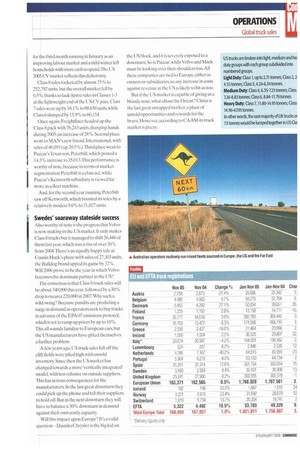Truck sales fell by 40% in the Netherlands last year
Page 50

Page 51

Page 52

Page 53

If you've noticed an error in this article please click here to report it so we can fix it.
but in the US demand for LGVs surged by 25%. Who cares? As Oliver Dixon explains, you should, because nowadays it really is a small world.
There were worse things to be doing on planet earth during 2005 then selling trucks, CM has already taken a stroll through the UK sales figures -it was yet another record year: now our thoughts turn to more distant shores.
This isn't a simple exercise in filling pages. In fact, anything that involves attempting to discern the vagaries of the Indian CV market is about as far away from simple as you can get, so we're earning our money here. But the performance of CV builders around the world is of increasing importance to the UK. Not because we make trucks any more we gave up that messy business some time ago-hut because planet earth is becoming so small.
Time was when economies thrived or withered pretty much in isolation.Tbis is no longer the case. And while at one level CV sales simply make the difference between a pat on the head or a kick in the backside for a truck salesman, at another they are a fairly accurate barometer of economic performance. And what happens over there now has a direct bearing on how we're likely to feel over here.
At the time of writing Ford has just canned 30,(P0 American workers.lbis isn't a good sign. But, conversely. US consumer confidence (as measured by the University of Michigan's Preliminary Index of Consumer Sentiment) rose from 91.5 to 93.4 in December and increased for the third month running in January as an improving labour market and a mild winter left households with more cash to spend:111e US 2005 CV market reflects this dichotomy.
Class 8 sales rocketed by almost 25% to 252,792 units, but the overall market fell by 05% thanks to lack-lustre sales in Classes 1-3 at the lightweight end of the US CV parc. Class 7 sales were up by 18.1 % to 88,658 units, while Class 6 slumped by 13.9% to 60,154.
)11ce again, Freightliner headed up the Class 8 pack with 76,243 units changing hands during 2005; an increase of 28%. Second place went to MAN's new friend, International, with sales of 46.093 (up 20.5% ).Third place went to Paecar'sTexan son, Peterbilt. which posted a 14.3% increase to 35.013.1Fhis performance is worthy of note, because in terms of market segmentation Peterbilt is a class act. while Paccar's Kenworth subsidiary is viewed far more as a fleet machine.
And, for the second year running. Peterhilt saw off Kenworth, which boosted its sales by a relatively modest 9.6% to 31.027 units.
Swedes' soaraway stateside success Also worthy of note is the progress that Volvo is now making in the US market. It only makes Class 8 trucks but it managed to shift 26,446 of them last year,which was a rise of over 30% from 2004.There's an equally happy tale at Cousin Mack's place: with sales of 27,303 units, the Bulldog brand upped its game by 32%. Will 2006 prove to he the year in which Volvo becomes the dominant partner in the US?
The consensus is that Class 8 truck sales will be about 340,000 this year. followed by a 30% drop to nearer 220.000 in 2007.Why such a wild swing? Because pundits are predicting a surge in demand as operators seek to buy trucks in advance of the EPA 07 emissions protocol, which is set to ramp up prices by up to 10%. 'Ibis all sounds familiar to European ears. but t he 11S manufacturers have gifted themselves a further problem.
A few years ago. US truck sales fell off the cliff, fields were piled high with unsold inventory Since then the US market has changed towards a more 'vertically integrated' model, with less reliance on outside suppliers. This has serious consequences for the manufacturers. In the last great downturn they could pick up the phone and tell their suppliers to hold off. But in the next downturn they will have to balance a 30% downturn in demand against their own costly capacity.
Will this impact upon Europe? It's a valid question DaimlerChrysler is the big kid on the 1.IS block, and it is severely exposed to a downturn. So is Paccar; while Volvo and Mack must be looking over their shoulders too.All these companies are tied to Europe, either as owners or subsidiaries, so any increase in costs against revenue in the I JS is likely to hit us too.
But if the US market is capable of giving us a bloody nose, what about the Orient? China is the last great untapped market:a place of untold opportunities and rewards for the brave. However, according to CAAM its truck market is jittery.
We only have the figures up until October 2005, but they don't paint an edifying picture. Heavy truck sales dropped 35.7% to October, with tractor units down 42.7%. In total, Chinese manufacturers sold 139 million CVs in that period: down 0.75% year on year. Worthy of mention is Jianghuai Motors, one of China's biggest CV manufacturers. It launched new heavy-duty trucks last April but sold just 555 units during the whole of 2005.
In part this slowdown may be a result of the Chinese government taking measures to take some of the heat out of the economy.This would explain some of the reduction in truck sales, as the need to shift raw materials reduced. State authorities have been struggling to cope with excess development in heavy industries such as steel and coke.To deal with this they have halted a number of development projects, cut back investment and closed down a number of operations. All of which has an impact on the need for transport.
Good reason for good cheer But according to Lhang Boshun, general secretary of the CA AM's Market and Trade Commission.there is still reason for good cheer. Quoted in the Shanghai press, he commented, somewhat enigmatically:"There is still market potential as more logistics companies will rely on heavy-duty trucks and help to cultivate a sales peak later.
There's a bit of logic in here. As the big logistics providers move into China they will demand vehicles assuming that a developing logistics infrastructure is key to the demand for transport. We're not sure this is the ease. China is many things, but a place of simple supply and demand it isn't.
What's more.outsourcing from the emerged markets is driving a large percentage of Chinese growth .If consumer spending within these markets dips an inevitable function of a cyclical global economy then demand for Chinese production will also fall. If their domestic demand remains constant,we fail to see how the Chinese market can put on the numbers that are bandied around by the automotive industry as a whole.
China has become the world's sweatshop: all well and good when the world is out shopping, but not so good when it's staying at home with a book.We have China filed under'needs watching' and as a result manufacturers which have poured resources and technology into the wishing well are also worthy of some scrutiny over the coming months. Across the water the Japanese markt.' I moved in the right direction, but, with a 0.2% increase (to 549.256 units) you'd only notice it in a good light.
However, the Japanese economy does seem to be dragging itself out of the doldrums possibly a dead-cat bounce but it's equally likely to he a precursor to some sustained growth:so the future looks pretty healthy for the Japanese manufacturers.With the exception of Scania,the homegrowns have the place to themselves.
But it's not just in Japan that the Japanese are having it larger. Australia and South Africa are two of the very few markets in which vehicle manufacturers from the three established regions compete head on. and both are doing rather nicely.
In Australia, for example, the Japanese cleaned up last year. In a market worth 34.732 units (up 8.6% over the previous year) Isuzu and Hino came home in first and second place. both posting increases over 2004.
Most of the market growth came in the 4.58.5-tonne sector, which recorded a 2,000-unit rise.The middleweight arena (8.5-16 tonnes) posted a more moderate 900-unit rise,while demand for heavies dipped slightly as increased fuel costs led operators to delay fleet replacement cycles. Many pundits expect this year to exhibit all of the symptoms of a business in a holding pattern. If anything, the heavy sector is likely to dip further, but this may be offset by further increases in the light and middleweight markets.
South Africa was similarly buoyant last year, with more than 27.400 units being sold second only to the record of 30,742 units set in 1981.And during that record year sales were artificially boosted by a pre-buying spike caused by the then government's plans to force companies to buy their truck engines from a state-owned plant.
A stronger rand and an improved economic environment all played their part in the South African market,with figures from the National Association of Automobile Manufacturers indicating growl]) in excess of 25%.
The middleweight sector went up by 42% during 2005. Heavy trucks between 8.5 tonnes and 16.5 tonnesposted an increase almost 40%.The plus-16.5-tonne market ro by almost 20%.
And what of next year? Depending on wl you talk to, expect South Africa to continue putting on numbers: we've heard predictioi of up to 20%. In part this estimate is based promises of infrastructure development:a long-term issue that may well make SA a booming market for the next five years.
Final stop is Europe. Germany, regarded some time as the sick man of Europe, looks be going in the right direction. With sales of 56,119 units above 16 tonnesup 4.4% onl year the tide may he turning. But it's probably more instructive to look beyond I borders of the Eli here.
From little acorns...
Bulgaria accedes to the E1J in 2007 and. admittedly from small beginnings, it's goini through the roof. Bulgarian Truck sales ros 53% to 1,241 units in 2()05,equally split between vehicles used for international transport and those kept busy on domestic work. Expect to see a 15-20% annual grow rate over the next five years You might not like it. but we exist today ir global economy.What's good for them is probably good for usAs such, last year's figi are reason for some good cheer. But there's cause for worry here as well. If the US mark drops by 30% then those waves are going tc on the European shore.Similarly,we think i right to flag up concerns about China.
The International Energy Agency has predicted that China's daily oil consumptii will increase by 210.000 barrels this year.T an increase of 3.3% from 2004, but its still ; long way below the 10% increase that's he reported in previous years.
So what? It takes energy to make a and it takes trucks to move things. China's real growth rate is refle by its energy consumption. ti those manufacturers that h; rushed headlong into that marketplace may have a problem. You can shoot down all you like here. t it's costing westerners to make every $1, that not good business. Ai a global world, bad business anywhere is had n, everywhere..






































































































































































































